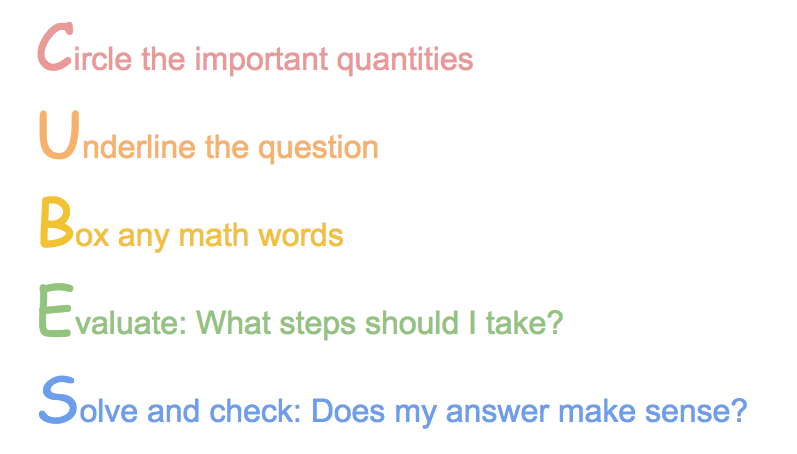It is well known that children often struggle to solve word problems in mathematics. One strategy that is used to support students with having access to word problems is called CUBES. Another is to have students identify all of the keywords in the problem. (Update: Margie Pearse wrote a longer response to these same two strategies here).

In these strategies, students are encouraged to chunk the information given in the word problem in a variety of different ways. For the CUBES strategy, the word quantities is often defined as numbers including units and direction (if given).
Let’s try out the CUBES strategy with the following word problem from the Mathematics Assessment Project. Why don’t you try it yourself first?

Here is my attempt, as if I were a student, on this task for just the first three of the steps in CUBES.

You’ll notice that I have circled a lot of unimportant quantities. I’ve also boxed some math words or expressions that are probably not helpful. These are reasonable things to expect many students to do. How does a child know that “three-course meal” is really a description of a kind of food and not a quantity in this context? We could easily imagine contexts in which the number of courses in a meal is important.
My point is that CUBES is an insufficient strategy to help students have entry to this problem. It might be helpful (sometimes) but it almost certainly not sufficient. There is a lot of thinking yet to be done before identifying the critical information from the problem and being able to solve the problem.
Here are some additional recommendations that you can combine as needed:
- Make sure students have access to the context itself. In this case, if students do not know what a three-course meal or a two-course meal are, it might be helpful to have pictures or a story that describes these things. If the context is one that you think you will revisit more than once, it may be helpful to act out the story.
- If you have students who are learning English as a new language, it may be helpful to work out, perhaps with other students in your class, a translation of the context into the language they know best.
- Have students restate, in a variety of different ways, what they think the context of the situation is about. This will both help students hear different ways of describing the situation and give you information about how students are making sense of the context.
- Let students ask questions about the context. While solving the problem for students may be counter-productive, answering questions students have about the context will both give you information about how they understand the context and give students helpful information that you may not have predicted they needed.
- It might be helpful to have students describe the relationships between the quantities and other information given. This might be by drawing a diagram or a mindmap. For a pair of routines that may be helpful here, try Capturing Quantities or Three Reads, both described in this book.
- After solving the problem as a group and ensuring that everyone understands the solution(s), come back and check which information from the problem was actually useful. Over time this may help students learn how to distinguish the relevant from the irrelevant information in the problem.